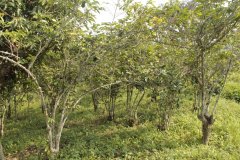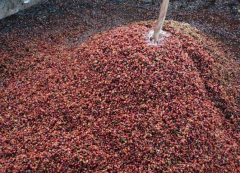Detailed data of hand punching temperature, grindability and water-powder ratio of Colombian water washing Cauca
For professional baristas, please follow the coffee workshop (Wechat official account cafe_style)

Country: Colombia
Grade: AATOP
Producing area: Cauca Valley
Altitude: 1800 m
Treatment: insolation
Variety: Rose summer
Manor: hope Manor
Flavor: berries, honey, vanilla, sweet juice
Ten years ago, most coffee farms in Colombia went all out to sprint production, and when the government advocated the cultivation of high-yield beans with strong disease resistance and discouraged good flavor but low yield, it was hoped that the manor would resolutely embark on the long road of fine coffee.
The opportunity the manor would like to see at that time was "Geisha" (also known as a geisha). After the Panamanian Emerald Manor became famous because of the rediscovery of rose summer in the garden, coffee farms around the world were studying the possibility of planting rose summer, but there was no rose summer variety in Colombia. It was hoped that the manor owner RigobertoHerrera sent the chief botanist HernandoTapasco to Panama to study, rented LaCardeida Farm next door to the Bogut Emerald Manor, and Tapasco himself stayed in Bogut for a year. Thoroughly study the planting and production technology of Rosa rugosa.
In December 2006, the Hope Manor bought the CerroAzul in Colombia's Cauca Valley, the geographical environment is very close to Poquette, the warm air rising from the Cauca Valley and the cold air from the Pacific meet at the manor. The manor has 20 hectares of arable land between 1700 and 1950 meters above sea level, originally planted with Caturra. In September 2007, 35,000 rose summer trees were planted. Unexpectedly, two months later, some of the saplings died, and Rigoberto's brother wanted to give up, thinking that the wind was too cold for planting and should be changed to cattle pasture. Rigoberto refused to admit defeat, insisted on replanting, and planted windbreaks on the top so that the strong wind would not destroy the coffee shrubs.
The rosy summers survived and won the second place in the annual World Coffee Competition of the American Fine Coffee Association in 2012, and the rosy summers of the other two estates of Hope Manor. A total of three places in the top 10: second, third and seventh, creating an incredible treble.
Hope that the manor is different from other manors, with doctoral botanists, three professional cup surveyors, 100 full-time employees, and currently manages a manor under its jurisdiction. The estate is owned by the Herrera brothers. In fact, the grandfather of the Herrera brothers, who ran a coffee farm in the Trujillo district of Colombia, gradually declined, and the two brothers left Colombia. But they did not give up their dream of going back to their hometown to run a coffee farm.
The first estate that Herrera bought when he returned home was Trujillo's LaEsperanza, which is very close to their grandfather's original farm and is now used as a regional headquarters. The manor itself is 100% organic, with a variety of coffee trees including Colombian species, Castillo, Caturra and more than 14000 organic roses. Next, Herrera bought four estates in Trujillo and Caicedonia, north of Trujillo. Together with the LaCardeida estate in Boquete, Panama, which was leased in 2005, it now has six estates and a total coffee planting area of 213 hectares.
CafeGranjaLaEsperanza's estate is located in eight unique microclimate regions of the three Colombian mountains, giving their botanists an excellent opportunity to experiment with different microclimates and land flavors, different treatments, and different coffee varieties, combining the rationality of scientists, the sense of smell of businessmen and their insistence on the quality of coffee. For example, they create different treatment steps and norms for different microclimates and varieties. From seedling cultivation to export, there are 95 data points to manage all the data.
HernandoTapasco's team, the lead botanist, set up a climate station on the estate to track weather data and help make harvest decisions. The data on the farm were collected continuously and analyzed once a week. After harvest, they will compare weather data, production data and cup test data and analyze the correlation. The harvesters of Rose Summer are strictly trained to collect only ripe cherry fruits and are paid by the day, unlike other manors by weight. In order to prevent workers from harvesting unqualified cherries in order to improve their performance, half of the harvesting workers have more than six years of experience. After the fruit is harvested, it will be sent to the central processing plant in Hope Manor, and each batch of rose will be marked and dealt with separately. First go through the drying stage three days ago in the sun field, and then move to the small tower to dry. Strict quality control is another key. There are 40, 000 to 45, 000 rose trees in CerroAzul Manor, of which only 5-7000 can produce rose beans with the CerroAzul brand.

The experiment and innovation of Hope Chateau on variety seems to be endless, constantly experimenting with different new varieties, in addition to the organic Kaddura, which used to make up the majority of the area of the Hope estate, from rose summer, organic rose summer, mocha, bourbon (including different red, yellow, Tekizik bourbon), pointed bourbon, Pakamara, San Bernardo and Pache, they really bring the chateau's serious attitude towards grape varieties to coffee. After the rose summer, from the Pacamara, Bourbon and even the pointed Bourbon produced by the Hope Manor, continue to create the surprise and admiration of the boutique coffee world.
In the naming of coffee, they like to label coffee products with the usual "GrandCru" label of wine, and they also like to use "reserve" to distinguish top batches. For example, "AAAreverseGeisha" is used to refer to only two of the seven varieties in CerroAzul, and it is also the most advanced, with the highest elevation (1800-2000 meters). According to the large amount of data and research accumulated by the manor, different forms will use different methods to give full play to the best flavor.
Their actions finally paid off. As early as the 2008 "Best Panama" competition, I hope that the LaCardeida rented by the manor will win the best Panama championship with a high score of 93.16. The best coffee treble of the year in 2012 was won by the three main growers of Rosa Rosa: CerroAzul second, LasMagarita third and Buenos Aires Experimental Manor seventh.
Wash the Columbia test card by hand. 15g powder, medium fineness grinding (sugar size), v60 filter cup, 90 degrees water temperature, 30g water injection for the first time, steaming for 30 seconds, water injection to 105g water cut off, wait for the powder bed water to reach half, then water injection, slow and uniform water injection until 225g water, finally shake the filter cup to increase the extraction, the ratio of water to powder is 1:15, and the extraction time is 2:04.
Important Notice :
前街咖啡 FrontStreet Coffee has moved to new addredd:
FrontStreet Coffee Address: 315,Donghua East Road,GuangZhou
Tel:020 38364473
- Prev

Detailed data of hand temperature, grindability and powder-to-water ratio of Colombian low-caffeine coffee
Professional baristas exchange please follow the coffee workshop (Wechat official account cafe_style) product introduction 1, solvent extraction 1. Direct extraction method: the raw coffee beans are softened, and then heated with high temperature (pressure) steam to expand the surface of the raw coffee beans, so that the contact area of the raw coffee beans increases, and then the dichloromethane solvent is poured into the bean to come into contact with the solvent. extract caffeine from coffee
- Next

Description of the source and flavor of the love elixir of Saint Ario Manor in Cauca, Colombia.
Professional barista communication please follow the coffee workshop (Wechat official account cafe_style) Saint Ali Manor love elixir Finca Santuario Red Bourbon country: Columbia: Cauca altitude: 1950-2050 m treatment: washing grade: Excelso variety: red bourbon flavor description: flower, fruit juice, orange, plum, honey, thick
Related
- Detailed explanation of Jadeite planting Land in Panamanian Jadeite Manor introduction to the grading system of Jadeite competitive bidding, Red bid, Green bid and Rose Summer
- Story of Coffee planting in Brenka region of Costa Rica Stonehenge Manor anaerobic heavy honey treatment of flavor mouth
- What's on the barrel of Blue Mountain Coffee beans?
- Can American coffee also pull flowers? How to use hot American style to pull out a good-looking pattern?
- Can you make a cold extract with coffee beans? What is the right proportion for cold-extracted coffee formula?
- Indonesian PWN Gold Mandrine Coffee Origin Features Flavor How to Chong? Mandolin coffee is American.
- A brief introduction to the flavor characteristics of Brazilian yellow bourbon coffee beans
- What is the effect of different water quality on the flavor of cold-extracted coffee? What kind of water is best for brewing coffee?
- Why do you think of Rose Summer whenever you mention Panamanian coffee?
- Introduction to the characteristics of authentic blue mountain coffee bean producing areas? What is the CIB Coffee Authority in Jamaica?

